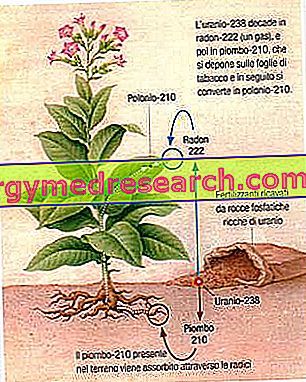Generality
Krapfen is the name of a sweet and fried food typical of the Austrian territory.

Although the original recipe of krapfen is only one, there are many variations that interest: cooking fat, sugar, flour, stuffing, etc.
Krapfen is a highly caloric product, rich in fat, carbohydrates and often cholesterol. For this reason, it does NOT lend itself to all types of diet and its frequent consumption could easily induce nutritional imbalance.
Description
The most curious feature of krapfen is the difference between the raw form and the cooked form. Like many sweets inflated by carbon dioxide in frying, this food also grows exponentially. The portioning of the "raw" pasta involves the cutting of discs with a diameter of 5-10 centimeters, only about 5-10 millimeters thick; at the end of the heat treatment, the krapfen obtained from these disks will have increased up to 15 times its total volume.
Ready to eat, the "fresh" krapfen has a slightly flattened spherical shape; the color is "pale hazel" on the vertices (which come into contact with the cooking fat) and tendentially yellow on the transversal line, where the surface does not interact as well with the heat exchanger. Better to be wary of krapfen with a light and uniform color, hypothetically less cooked and therefore indigestible, or those that are too dark, potentially too cooked or cooked in excessively exhausted and dirty grease.
In general, donuts are covered with sugar or icing sugar, the consistency of which may be another indicator of good or poor quality of the product. In fact, a cake fried to perfection, therefore not soaked in oil and well buffered, leaves the sugar completely dry; on the contrary, when the sugar settles and becomes translucent, it means that the krapfen is decidedly too greasy and / or stale and / or badly preserved.
Since it is a sweet filling, on one of the two sides of the CONTEMPORARY krapfen the entry hole of the syringe or pastry bag is almost always clearly visible. The original filling is the canine or plum or apricot jam; on the other hand, in Italy there are even more widespread cream custard, diplomatic cream and hazelnut and cocoa cream (nutella type).
WARNING! It is not certain that the transfer of the content from the hole necessarily indicates an abundance of the filling. In fact, the internal space dedicated to the filling housing is formed spontaneously by leavening the dough during cooking. Carbon dioxide, while expanding with heat, remains trapped in the gluten of the dough creating a "sponge" characterized by more or less thick and voluminous cells. The lower density of the dough (the more leavened one) allows it to accommodate a greater volume of filling but, at the same time, a krapfen with too much yeast or poorly kneaded contains large bubbles that make it collapse or explode during the first bite. In this sense, even the quality of the flour (presence of gluten) plays a fundamental role. On the other hand, a too "massive" krapfen (therefore with small and dense leavening cells) hosts little filling and is more daring to chew and knead with saliva
Historical outline and Etymology
As anticipated, krapfen is a sweet native of Austria. More precisely, it seems that the birthplace was the city of Graz, the capital of Styria. In the local gastronomy, krapfen has the task of enriching the carnival banquets, a function emulated in many other nations that have absorbed the recipe.
The origin of the term "krapfen" does not boast the same clarity. In this regard, two distinct theories have been formulated: the first concerns the ancient German noun indicating the "frittella", or "krafo"; the second indicates the surname of the pastry chef who, at the end of the 17th century AD, invented donuts: Veronica Krapft.
Krapfen recipe
We quote below the hypothetically "original" recipe of donuts. The modern donut in Italy is NOT stuffed before cooking, but later!
Ingredients
- wheat flour type 00 250g
- 25g brewer's yeast
- 125ml whole milk
- whole egg n ° 1
- egg yolks n ° 2
- granular sugar 20g
- peel of 1 grated lemon
- melted butter 60g
- apricot jam 150g
- lard for frying 500g
- vanilla icing sugar QB
- salt a pinch.
| Composition for: 100g of Krapfen with jam | ||||||||||||||||||||||||||||||||||||||||||||||||||||||||||||||||||||||||||||||||||||||||||||||||||||||||||||||||||||||||||||||||||||||||||||
 | ||||||||||||||||||||||||||||||||||||||||||||||||||||||||||||||||||||||||||||||||||||||||||||||||||||||||||||||||||||||||||||||||||||||||||||
Nutritional values (per 100 g of edible portion)
| ||||||||||||||||||||||||||||||||||||||||||||||||||||||||||||||||||||||||||||||||||||||||||||||||||||||||||||||||||||||||||||||||||||||||||||
Method
Dissolve the yeast in a little warm milk with a little flour; place this batter to rise at least 2 hours in a warm place and in a sealed container.
Once the volume of the batter has doubled, gradually add the flour, a pinch of salt, the beaten eggs and egg yolks, the granulated sugar and the lemon peel. Stir vigorously and stir in the melted butter.
Spread on a floured surface to a thickness of about 1cm and, with a pasta bowl, cut some discs of about 8cm. At the center of the disks, place a spoonful of jam and close with another empty disk, taking care to tighten the edges.
Let rise 2 hours in a warm place and in a sealed container.
Fry them in abundant lard, dry them VERY WELL and sprinkle them with vanilla icing sugar.
NB . If you want to stuff it after cooking, it is not necessary to overlap the discs, they will be fried individually and filled with a pastry bag or with a special syringe.
Nutritional characteristics
The nutritional values of krapfen are very different depending on the recipe. The variables that most compromise the supply of energy and nutrients are the fat used and the filling.
If lard or butter is used, the intake of saturated fat and cholesterol increases significantly with a negative effect on cholesterolemia. At the same time, the choice of the filling oscillates between jam, custard, diplomatic cream and cocoa hazelnut cream (nutella type); in the latter case, the already very high fat intake for the frying process, further increases making the preparation a caloric BOMB. After the chocolate, in second place (for fatness) we find the diplomatic cream (erroneously called chantilly) composed of a part of whipped cream. Finally, custard and marmalade are added to the list, whereas they are richer in carbohydrates (simple and, in pastry, even complex). Obviously, the presence of eggs (already intrinsic in the dough) in custard or diplomatic helps to increase the total cholesterol content of donuts. Then, the omnipresent richness of sucrose makes it unsuitable for the diabetic's diet.
The krapfen NEVER constitutes a product suitable for the nutrition of the overweight person or of one suffering from metabolic diseases. The table shows the nutritional values of the recipe mentioned in the previous paragraph, while the video of a much lighter and healthier variant is shown below: light baked donuts.
Very light oven baked donuts - Krapfen Non Fritti
X Problems with video playback? Reload from YouTube Go to Video Page Go to Video Recipes Section Watch the video on youtubeFor those looking for an even lighter variant, we recommend the videorecetta of the super-soft donuts with potatoes.



